Invest in Women Artists: Support Them While They're Alive
- Jenny Munoz
- Apr 4, 2024
- 4 min read
Updated: Apr 6, 2024

As an art advisor and connoisseur, I've witnessed the profound impact women artists have made on the art world. However, it's disheartening to see that even now, the spotlight shines brightest on those no longer with us. While it's essential to recognize the contributions of past female artists, we mustn't overlook the talented women creating groundbreaking work today.
It's time to shift our focus from posthumous praise to proactive support. Let's not confine our celebration of women artists to just one month of the year. Every month should be an opportunity to champion their talent and amplify their voices.
March has evolved into a month where social media is inundated with Instagram posts proclaiming support for women. While this gesture is appreciated, it's imperative to recognize that advocating for women should not be confined to a single month or limited to fleeting social media posts. As we transition into April, it presents an opportune moment for substantive and ongoing support rather than mere symbolic gestures.
Many women artists throughout history never had the chance to flourish fully during their lifetimes. Despite their undeniable talent, they struggled to make a living from their art. We owe it to them and ourselves to ensure that contemporary women artists have the support they need to thrive.
Carmen Herrera. Image courtesy of National Women's History Museum.
Carmen Herrera (1915-2022, Cuban American) stands as a poignant example of why we must support women artists in the early stages of their careers rather than waiting until they are in their elderly years. Despite studying art in New York City, developing her distinct style, and cultivating a rich network amongst artists and intellectuals, such as philosophers Simone de Beauvoir and Jean-Paul Sartre, in New York and Paris, Herrera struggled to make a living from her art simply because she was a woman. While her male peers, such as Mark Rothko, gained recognition and success, Herrera remained in the shadows.
Herrera herself remarked that being a woman was a significant hindrance in the art world. When she tried to submit her artwork for an exhibition at the Rose Fried Gallery, the female curator, Rose Fried, informed her that her work couldn't be included solely because she was a woman. Despite these challenges, Herrera persisted in her artistic pursuits without receiving recognition until she was discovered later in life, starting in the early 2000s when she was in her 80s.
This delayed recognition highlights the urgent need to support women artists from the early stages of their careers, ensuring they receive the recognition and opportunities they deserve without having to wait until they are near the end of their lives to be valued by the art world.
Carmen Herrera, "Blanco y Verde" (1966). Image courtesy of Sotheby's.
According to Artsy, Carmen Herrera's market performance has been impressive over the past 36 months. An average of 8 lots have been sold annually, a remarkable sell-through rate of 89.6%, and a sale price averaging $325,000, often exceeding estimates by 18%.
One notable instance of Herrera's rising recognition occurred in 2019 when Sotheby's sold her painting titled "BLANCO Y VERDE" (1966) for an astonishing US$2,900,000, a remarkable 66% above the estimated price. This sale stands as the highest auction result for the artist to date, occurring just three years before her passing at the remarkable age of 106.
Carmen Herrera's career is not an anomaly; instead, it reflects a broader trend of "discovering" women artists who are either in their later years or have recently passed away. It's become increasingly common for art dealers and galleries to capitalize on the legacies of deceased women artists by organizing retrospectives that yield profits without directly benefiting the artists themselves. True advocacy for gender equality in the art world transcends mere lip service—it entails actively investing in the careers of living artists.
Phoebe Boddy in her recent debut solo exhibition, "Reverse Cowgirl," at our pop-up gallery in London.
At The Nomad Salon, we're dedicated to implementing our principles. Last year, we launched our "Art Collector's Home" series, featuring a group exhibition in a domestic setting at our Salon in Little Venice, London. This series will be a recurring event every summer. Furthermore, we've recently initiated a program of pop-up gallery exhibitions spotlighting solo artists. The exhibition program is exclusively for championing women artists. In the image above, you can see London-based artist Phoebe Boddy at her debut solo show in our first pop-up gallery in Shoreditch. If you're interested in investing in her career or any other artist we feature, please don't hesitate to contact me here. We strongly believe in supporting artists from the early stages of their careers, offering them the resources and recognition they deserve to thrive as professionals.
Let's make a real difference in the lives of women artists by investing in them while they're alive, ensuring that they can pursue their passion and achieve success. It's not just about celebrating the past—it's about shaping the future of art.



